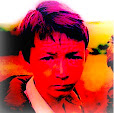Gregory Colbert - Ashes and Snow
30.6.12
o fascínio
Isluga - Parque Nacional Volcán Isluga - Chile
Milky Way and Altiplano Church by Stephane Guisard
The magnificent Milky Way and bright planet Jupiter shine above Isluga village located in the Volcan Isluga National park on the Chilean Altiplano, at altitude of 4200m above sea level. Its name comes from the nearby Isluga volcano (5550 m). As noted by the photographer “It is mostly a ceremonial village now, being deserted during most of the year. Isluga is well known for its nice little white church built in the 17th century, a typical architecture of Altiplano churches. The church has adobe walls and a tile roof, and the bell tower is separated from the church itself.” Stephane Guisard - Astrosurf.com/sguisard.
www.twanight.org
26.6.12
Angels of Anarchy
"The Angel of Anarchy" by Eileen Agar
Angels of Anarchy – Manchester Art Gallery
Angels of Anarchy is the first major exhibition to be held in Europe on women artists in Surrealism, celebrating the contribution these outstanding women played in one of the greatest movements in art history.
The exhibition title, taken from a work by Eileen Agar, hints at a subtly recurring theme found throughout; these ‘angels’ dare to push their artistry forwards in an almost rebellious, somewhat dissatisfied and provocative manner, whilst retaining sexuality, femininity and mysticism.
As we approach the 90th anniversary of Surrealism, there seems like no better place than Manchester to play host, as Fiona Corridan, a curator of the exhibition explains, “there is a high pedigree in Manchester’s art galleries. If you look at the radical nature of Manchester’s history, the Suffragettes, for example, it fits with the radicalism in the exhibition.”
Opening our eyes to lesser known, slightly more obscure artists alongside works by Frida Khalo and Lee Miller, the exhibition promises to be a once in a lifetime opportunity to enjoy such a vast collection of important works. “A revisionist take on Surrealism,” says Fiona Corridan, “which highlights a forgotten history.”
Visit www.manchestergalleries.org/angelsofanarchy for more information.
[ The ironing board image comes from Comte de Lautréamont (1868) Les Chants de Maldoror written in Paris.
Agar produced a first version of the Angel in 1937, it was lost and the second version, illustrated, was made in 1940-3.
Two books in particular have informed this post: Eileen Agar (1988) A Look at My Life (Methuen, London); and Michel Remy (1999) Surrealism in Britain (Ashgate, London). ]
Bard and Agar in 1937
Eileen Agar (1904-1991) and husband since 1940, Hungarian Joseph Bard (1889-1975) by Roland Penrose (1900-1984)
22.6.12
21.6.12
Emmanuelle
Pierre Bachelet & Herve Roy - Emmanuelle OST (1974)
Quality: mp3 : 320 kbps : 66.62 MB
Total Time:35':22''
Quality: mp3 : 320 kbps : 66.62 MB
Total Time:35':22''
download
20.6.12
em memória [tão curta a vida, tão longa a arte de...]
Paula
1972 - 2012
Aquele que ama e crê
Não chora num sepulcro,
Do amor os doces bens
Ninguém rouba nenhum.
A noite que enebria
Abranda-lhe a saudade —
Do céu os melhores filhos
O coração lhe guardam.
Novalis
Foto: Toni Frissell - A model floating in the water at Weeki Wachee Spring, Florida 1947.
18.6.12
17.6.12
Horto dos Incêndios
Homens cegos procuram a visão do amor
onde os dias ergueram esta parede
intransponível
caminham vergados no zumbido dos ventos
com os braços erguidos - cantam
a linha do horizonte é uma lâmina
corta os cabelos dos meteoros - corta
as faces dos homens que espreitam para o palco
nocturno das invisíveis cidades
escorre uma linfa prateada para o coração dos cegos
e o sono atormenta-os com os seus sonhos vazios
adormecem sempre
antes que a cinza dos olhos arda
e se disperse
no fundo do muito longe ouve-se
um lamento escuro
quando a alba se levanta de novo no horto
dos incêndios
prosseguem caminho
com a voz atada por uma corda de lírios
os cegos
são o corpo de um fogo lento - uma sarça
que se acende subitamente por dentro.
Al Berto
Rain dogs
‘In 1967, Anders Petersen started to photograph the late-night regulars (prostitutes, transvestites, drunks, lovers, drug addicts) in a bar in Hamburg, Germany, named Café Lehmitz, and continued that project for three years. 88 b&w photographs in his photobook of the same name was published eight years later in 1978 by Schirmer/Mosel in Germany, and then appeared in France (1979) and Sweden (1982). Café Lehmitz has since become regarded as a seminal book in the history of European photography.
‘The people at the Café Lehmitz had a presence and a sincerity that I myself lacked. It was okay to be desperate, to be tender, to sit all alone or share the company of others. There was a great warmth and tolerance in this destitute setting.’
When I looked at Café Lehmitz years afterwards, I suddenly realised it was just like a typical family album. [...] It was a real lesson for me, a young, respectable boy from Sweden. A lesson in how to live.’
... ... “After a while, I did not know what I was doing in Café Lehmitz and that is when I felt at home”
- Anders Petersen
- Wikipedia
Café Lehmitz [1967-1970] by Anders Petersen
Subscrever:
Mensagens (Atom)

























































































































